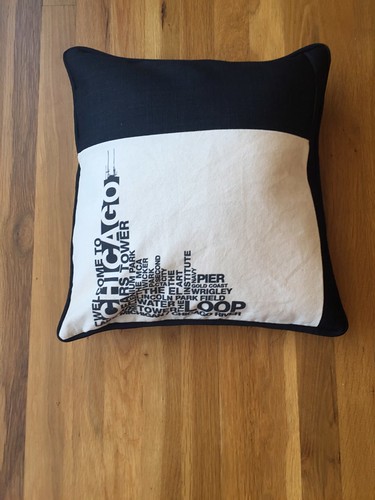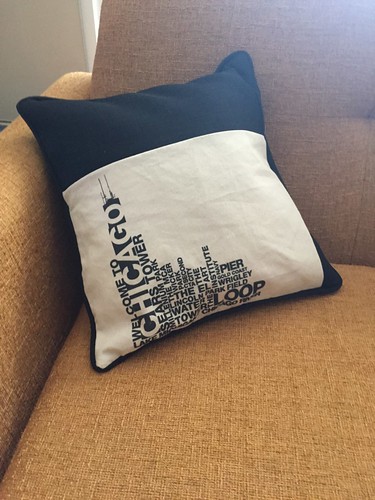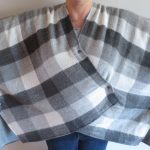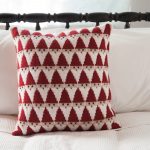My Aunt invited all the women in my family to gather in Chicago. The trip was a smashing success that even Ferris Bueller would have been proud of. One clever piece of her invitation was this graphic tote bag.

The text becomes iconic and the canvas is always a great fabric, so I took used the bag as the inspiration and made it into a gift for my aunt. (It came out while we were on the trip that she did not give herself a bag. I understand why she didn’t do that. You wouldn’t really send yourself an invitation to your own party. But still, I thought she should have one in her house.) I took the bag and reworked it into something that she could have out and use every day (not just on shopping day.)
Canvas Tote Bag Pillow
Supplies:
- One bag
- Backing (and accent fabric if the bag front needs different dimensions)
- Piping
- Coordinating thread
- Zipper
Directions:
This project starts with deconstructing the bag. The trick here was to keep as much of the front in tact as possible. I thought this would be super easy because the print looks centered on the bag, but, in fact, the print on the bag is as close to the top as it could be. The bag is designed so that when it fills and expands the logo will still show and not be absorbed into the bottom of the bag that folds out. The Sears Tower antennae are almost touching the top of the bag. I made the panel a feature and moved it down and off to the side. It’s a design choice. The pillow front is asymmetrical and unexpected.
Start by deconstructing the bag. I used scissors and cut all around as close to the seams as I could get. Then I worked out how I wanted the layout to go. I added black fabric to set the panel where I wanted it to go. Cut strips bigger than you want the top of the pillow to be so that you have room to square it off, and still have a healthy seam allowance. Sew the trim pieces on one at a time, and iron your work flat between seams.
- Cut the back piece of fabric the size you need for your pillow. Zig-zag around the edges for stability.
- Attach the pipe to one side of fabric. I used pre-made piping. The seam allowance is 1/2″ on most of the pre-made pipe, but the zipper will be easier to set in if you have a larger seam allowance. So as you run your piping around the pillow, especially along the bottom (or zipper side) take care to give yourself a full 5/8 seam allowance. Take the pipe, and lay it down on your pillow front. You will start at the bottom 3rd of one side. Some amazing sewers do this with no pins. That is not me. I don’t use a TON of pins because sometimes the fabric stretches a little bit and sometimes the pipe stretches a little bit so, if you used a million pins, you will now be locked in with a fight over what to do about the excess on your hands. Also, it is very hard to pin within a 1/2″ seam allowance. I like pins to be perpendicular and to get a pin to go in and back out, perpendicular, in 1/2 an inch is TOUGH. I start out and pin it around with one pin on the end and one pin in the middle of each side. The first pins are very well laid out, and the rest are a little bit more casual. I start to sew, and remove the pins carefully. Sew to within 1/2 inch of the corner (that is your seam allowance) and then place the needle down into the fabric. Carefully pull the pipe to form the corner. Take some sharp scissors and clip the seam allowance on the pipe to help it bend around the corner with the precision and sharp angle that you are looking for. Then lift the presser foot and pivot turn your fabric 90 degrees to make the corner, and start down the second side. Continue in this fashion on each corner. When you have gone all the way around you have two options for treatment of “ends of the cord”. One is to just overlap them. The other is to carefully splice the cord and trim and sew the fabric cover to make an invisible join. The choice is yours based on personal preference, time and skill level.
- Insert the zipper to the bottom edge of what will be your pillow. Here is where the tricks begin. I thought I would just set the zipper using the same method I would for an invisible zipper.
- Line up the bottom side of the front and the back piece. Stitch two inches with a regular small stitch. Try to follow the same line where you sewed the pipe on so that there are no seam lines visible from the outside. Change the stitch length to long stitches. Sew to within two inches from the end of the seam. Change the stitch length back to short stitches and sew the last two inches. What you have done is to make the start and the end of the seam strong, and the middle of the seam is just held in place while you add the zipper behind it.
- Open the seam and press it with an iron. Here, you are going to set the zipper in the bottom seam. This becomes a little bit tricky with the pipe and the fabric on one side and only 1/2″ seam allowance. I would suggest hand basting to get the zipper in exactly the right place. Then, with a zipper foot on your machine, slowly, carefully insert the zipper. I did an extra step, and top stitched a little bit so that the fabric hid the zipper a little bit more, but technically, you should not have to do this.
- Now that the zipper is in, take a seam ripper and gently rip open the stitches in the “middle” of the seam, exposing the zipper pull. Open and close the zipper to see that everything is working. (If there are things you don’t like, now is the time to make corrections.)
- Open the zipper a little bit (so there is a hole to turn the pillow inside out easily). Line up the front and the back and place a few pins in to hold everything in place. Sew the other three sides closed.
- Open the zipper all the way. Put the pillow insert into the case.
- Zip it closed and admire it.
© 2005 – 2015 Kathy Lewinski & Susan Cornish






